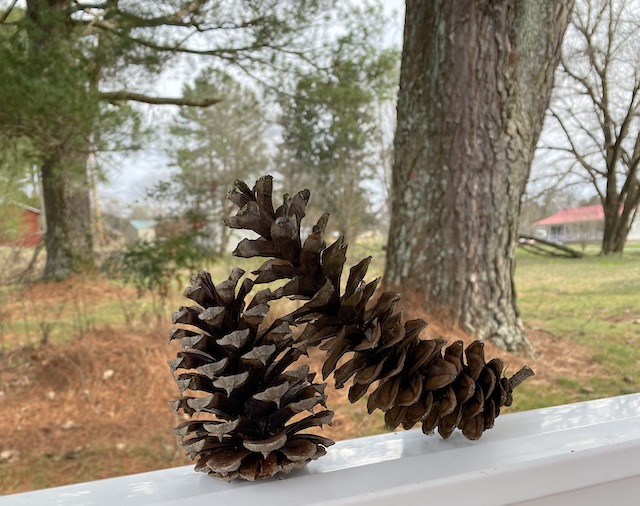| ||||||||||
Dr. Ronald P. Rogers CHIROPRACTOR Support for your body's natural healing capabilities 270-384-5554 Click here for details 


Columbia Gas Dept. GAS LEAK or GAS SMELL Contact Numbers 24 hrs/ 365 days 270-384-2006 or 9-1-1 Call before you dig Visit ColumbiaMagazine's Directory of Churches Addresses, times, phone numbers and more for churches in Adair County Find Great Stuff in ColumbiaMagazine's Classified Ads Antiques, Help Wanted, Autos, Real Estate, Legal Notices, More... 
|
Kentucky Color: Dissimilar Cones By Billy Joe Fudge There are many who ascribe to the philosophy that states "if you've seen one mountain, you've seen them all." Well, even if that were true with mountains, it certainly would not be true with pine cones. The more stocky heavy cone in the accompanying photo is a Loblolly Pine cone and the tree in the foreground is a Loblolly. Another more common name for Loblolly is Southern Pine. About all pine have edible seed which is produced at the base of the little tabs called scales. Usually there are two in each scale. They are called pine nuts and can be purchased at the grocery. You can see that most Loblolly scales have a thorny thingamabob on the ends. These are called prickles and yes, they are quite sharp and caution should be exercised in picking them up. These prickles will, as you might expect, get tangled in the hair of animals which help to spread the cones with their seed across the countryside. Birds and squirrels love the pine nuts. The squirrels just love to cut the scales off in their search for the tiny nuts and at the same time, they love dropping the scales on unsuspecting homeowners sitting beneath them during feeding time. The longer, more slightly built cone is an Eastern White Pine cone. The tree in the background is a White Pine. The White Pine cones are usually larger than the Loblolly but will weigh considerably less. You might notice that these scales have no prickles. However nature did not forget that they also need to use animals to disseminate their seed and gave them a very sticky patch of pine sap or resin on the tips of most scales. This will stick to the hair of animals without the aid of prickles and accomplish the same goal without the prickles. Pine tree sap contains sugars just as the sap in deciduous trees such as Oak, Hickory and Poplar but is much more concentrated in pines as in hardwoods. Most of the sap in hardwoods flows into the roots during their winter dormant period. Pines, however, are evergreens and evergreens retain much more sap in the trunk and limbs during winter, therefore they need greater concentrations of sugar to keep the sap from freezing which would rupture the cells, killing the trees. I have another little tidbit of information for you. During times of low relative humidity and sunshine, the scales of pine cones will be open. Then, when the air is damp and rainy, the scales will pull up tight against the central stem and appear to be about half their size when it is dry. During these times the Loblolly will be almost indestructible. This continual opening and closing will help to get the seed out of the cone where they can find soil in which to germinate. This story was posted on 2022-03-16 07:28:10
Printable: this page is now automatically formatted for printing.
Have comments or corrections for this story? Use our contact form and let us know.
More articles from topic Kentucky Color by Billy Joe Fudge:
Kentucky Color: 10 reasons to save the American Chestnut Kentucky Color: American Chestnut Dinosaur Kentucky Color: Health Threat Kentucky Color: Spring is Near Kentucky Color: Bone Chilling Kentucky Color: The Great Wooded South Kentucky Color: A Tad Unnerving Kentucky Color: Great Wooded South Thanksgiving Adair, by Billy Joe Fudge Kentucky Color: The Chase View even more articles in topic Kentucky Color by Billy Joe Fudge |



|
||||||||
|
| ||||||||||
|
Quick Links to Popular Features
Looking for a story or picture? Try our Photo Archive or our Stories Archive for all the information that's appeared on ColumbiaMagazine.com. | ||||||||||
|
Contact us: Columbia Magazine and columbiamagazine.com are published by Linda Waggener and Pen Waggener, PO Box 906, Columbia, KY 42728. Please use our contact page, or send questions about technical issues with this site to webmaster@columbiamagazine.com. All logos and trademarks used on this site are property of their respective owners. All comments remain the property and responsibility of their posters, all articles and photos remain the property of their creators, and all the rest is copyright 1995-Present by Columbia Magazine. Privacy policy: use of this site requires no sharing of information. Voluntarily shared information may be published and made available to the public on this site and/or stored electronically. Anonymous submissions will be subject to additional verification. Cookies are not required to use our site. However, if you have cookies enabled in your web browser, some of our advertisers may use cookies for interest-based advertising across multiple domains. For more information about third-party advertising, visit the NAI web privacy site.
| ||||||||||

















































